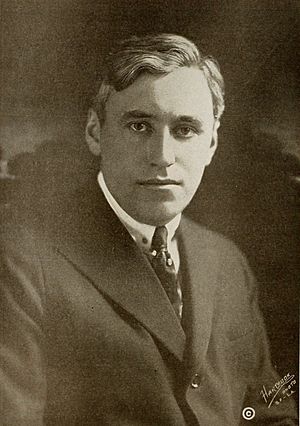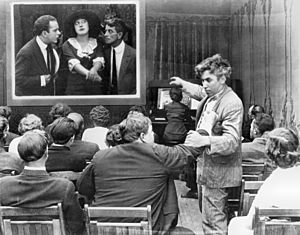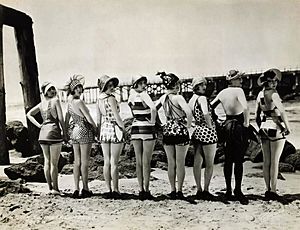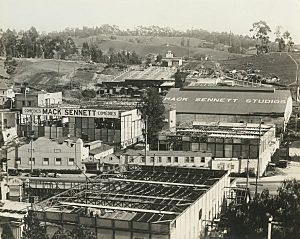Mack Sennett facts for kids
Quick facts for kids
Mack Sennett
|
|
|---|---|

The Moving Picture World, 1916
|
|
| Born |
Michael Sinnott
January 17, 1880 Danville, Quebec, Canada
|
| Died | November 5, 1960 (aged 80) |
| Occupation |
|
| Years active | 1908–1949 |
Mack Sennett (born Michael Sinnott; January 17, 1880 – November 5, 1960) was a Canadian actor and filmmaker. He was often called the 'King of Comedy' because of his important work in early movies.
Born in Danville, Quebec, Canada, in 1880, Sennett started his film career with the Biograph Company in New York City. Later, in 1912, he opened Keystone Studios in Edendale, California. This studio had the first fully enclosed film stage. Sennett became famous for creating slapstick comedy routines. These included funny pie-throwing scenes and exciting car chases, which you can see in his famous Keystone Cops films. He also produced short films that featured his Sennett Bathing Beauties. Many of these women later became successful actors.
Sennett's work in movies with sound was not as successful. He faced money problems and went bankrupt in 1933. However, in 1938, he received a special Academy Award for his huge contributions to film comedy.
Contents
Early Life and Dreams
Michael Sinnott was born in Danville, Quebec, Canada. His parents were John Sinnott and Catherine Foy. When he was 17, he moved to Connecticut in the United States.
He later lived in Northampton, Massachusetts. According to his own story, he first thought about becoming an opera singer there. He saw a vaudeville show, which was a type of entertainment with different acts. Even the town's respected lawyer, Calvin Coolidge (who later became President of the United States), and Sennett's mother tried to talk him out of his singing dreams.
In New York City, he changed his name to Mack Sennett. He became an actor, singer, dancer, clown, and director for the Biograph Company. He even played a funny version of Sherlock Holmes 11 times between 1911 and 1913.
Keystone Studios: The Fun Factory
In 1912, Mack Sennett started Keystone Studios in Edendale, California. This area is now part of Echo Park. He got financial help from Adam Kessel and Charles O. Bauman. The main building of the studio was the very first fully enclosed film stage ever built, and it is still standing today.
Many famous actors started their careers with Sennett. These include Mabel Normand, Charles Chaplin, Roscoe Arbuckle, Harold Lloyd, Gloria Swanson, and Bing Crosby.
Sennett's studios were known as the 'King of Hollywood's Fun Factory'. They made slapstick comedies famous for wild car chases and messy custard pie fights. The Keystone Cops series is a great example of this. These comedies focused on funny situations rather than deep characters. The actors often played silly types, like someone with a funny mustache or who was very clumsy.
Mabel Normand was Sennett's first female comedian. She became a big star under his guidance. Sennett also created the Kid Comedies, which were like an early version of the Our Gang films. Soon, his name was linked with screen comedy, which people called "flickers" back then. In 1915, Keystone Studios joined the Triangle Film Corporation. Sennett worked with other powerful film figures, D. W. Griffith and Thomas Ince.
Sennett Bathing Beauties
Starting in 1915, Sennett gathered a group of women known as the Sennett Bathing Beauties. They appeared in funny short films wearing swimsuits. They also showed up in advertisements and at events like beauty contests at Venice Beach. The Sennett Bathing Beauties were popular until 1928.
New Beginnings and Challenges
In 1917, Sennett left the Keystone trademark behind. He started his own company, Mack Sennett Comedies Corporation. The old Keystone trademark was used for some cheap comedy shorts, but Sennett was not involved with them.
Sennett then made more ambitious comedy short films and some longer movies. In the 1920s, his short films were very popular. They featured stars like Louise Fazenda, Billy Bevan, and Harry Langdon. He also made feature films with his biggest stars, such as Ben Turpin and Mabel Normand.
Many of Sennett's films from the early 1920s were later owned by Warner Bros. Studio. Unfortunately, many of these films were lost because they were not stored properly. This means that many of Sennett's best and most creative films no longer exist today.
Moving to Pathé Exchange
In the mid-1920s, Sennett began distributing his films through Pathé Exchange. Pathé was a very large company. However, they made some poor business choices, like trying to sell too many comedies at once. This included films from Sennett's main competitor, Hal Roach.
By 1927, big studios like Metro-Goldwyn-Mayer (MGM) and Paramount Pictures noticed how much money smaller companies were making. MGM and Paramount started making and distributing short films again. Hal Roach joined MGM, but Mack Sennett stayed with Pathé Exchange, even when times were tough. Many movie theaters started showing films from the new MGM or Paramount studios instead of Pathé.
Awards and Tough Times

Mack Sennett managed to switch to making sound films quite well. He released them through Educational Pictures. He even experimented with color films sometimes. In 1928, he was the first to release a short film with sound.
In 1932, he was nominated for an Academy Award for Live Action Short Film for his comedy The Loud Mouth. He also won an Academy Award in a different category for his film Wrestling Swordfish in the same year. He became a United States citizen on March 25, 1932.
However, Sennett sometimes stuck to older filmmaking methods. This made his early 1930s films seem a bit old-fashioned. His attempt to make longer movies again with Hypnotized was not very successful. But he did have great success with short comedies starring Bing Crosby. These films helped Sennett's work get picked up by a major studio, Paramount Pictures. The famous comedian W. C. Fields also starred in four popular Sennett-Paramount comedies.
Sennett's studio did not survive the Great Depression. His partnership with Paramount lasted only one year. He was forced to declare bankruptcy in November 1933.
His last work as a producer-director was in 1935 for Educational Pictures. He directed Buster Keaton in The Timid Young Man and Joan Davis in Way Up Thar.
Mack Sennett mostly retired at age 55. He had produced over 1,000 silent films and many sound films during his 25-year career. His studio property was bought by Mascot Pictures. Many of his former staff found jobs at Columbia Pictures.
In March 1938, Sennett received a special Academy Award. It honored him "for his lasting contribution to the comedy technique of the screen." The award recognized him as a "master of fun, discoverer of stars, sympathetic, kindly, understanding comedy genius."
Later Years
There were rumors that Sennett would return to making films. However, he mostly just re-released some of his old Bing Crosby films. He did appear in front of the camera in Hollywood Cavalcade (1939). This movie was a story loosely based on his romance with Mabel Normand.
In 1949, he provided film clips and appeared in the first full-length comedy collection called Down Memory Lane. He was also featured on the television show This Is Your Life in 1954. He made a small appearance in Abbott and Costello Meet the Keystone Kops (1955). His last notable contribution was to a radio program in 1956, where he shared memories of working with W.C. Fields.
Death
Mack Sennett died on November 5, 1960, in Woodland Hills, California. He was 80 years old. He was buried in the Holy Cross Cemetery in Culver City, California.
Filmography
Tributes
Mack Sennett has a star on the Hollywood Walk of Fame at 6712 Hollywood Boulevard. This honors his important contributions to the movie industry. He was also added to Canada's Walk of Fame in 2014.
See also
 In Spanish: Mack Sennett para niños
In Spanish: Mack Sennett para niños





